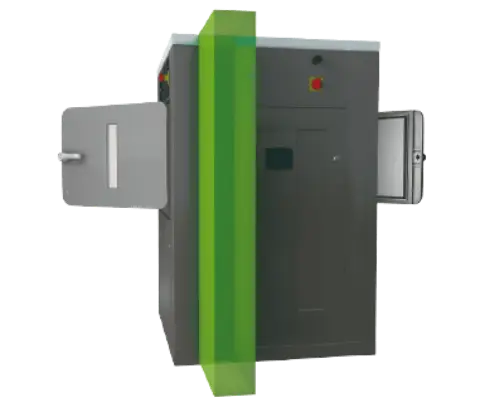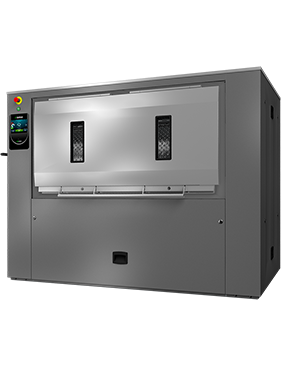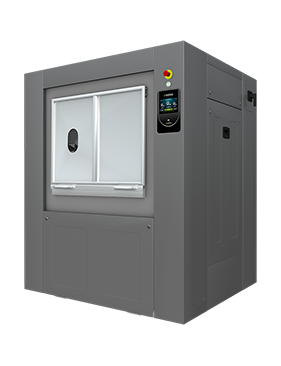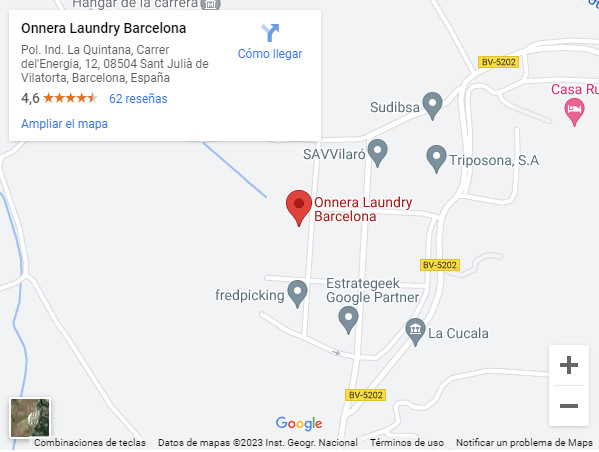25 October 2023
What are hospital laundries and how do they work?
In this blog we tell you what industrial hospital laundries are, what areas you can find in a laundry, how they work and how laundry is done in a hospital laundry.
For Domus, one of the most important aspects in the healthcare sector is the care and hygiene of linen in hospitals. This type of linen requires extreme caution due to the continuous possibility of contamination. For this reason, and in the wake of the global Covid-19 pandemic, hospital laundries have become one of the most important sectors in industrial laundry.
What are hospital laundries?
A hospital laundry is the space that provides the service of washing, reconditioning and ironing of textile garments in hospitals and health centres. The purpose of this service is to process soiled and contaminated linen and then manage it once clean and free of microbial contamination to the hospital or health centre services that require it. The health sector must have an infrastructure in place to process the required type and quantity of textiles.

Hospital laundries: characteristics
This type of infrastructure must comply with a series of requirements and characteristics in order to offer the best service.
- The dirty linen sector should be separated from the clean linen sector, with separate entrances and each with access to a hand-washing sink.
- The walls should not show signs of damp or deterioration and the surfaces should be made of washable material.
- Storage of clean linen should not be shared with soiled linen. Each sector should have tables, shelves and cupboards made of washable material.
- The soiled linen sector should have negative air pressure in relation to the clean linen sector.
- Work should be organised in one direction only and always in the same direction: from dirty to clean.
- Water should be expelled and drained in the soiled linen area.
- An area, as far as possible separate from the laundry, should be set aside for the reconditioning and/or sewing of hospital linen.
- The laundry should have changing areas, toilets and a refreshment area. These may be their own or shared with the rest of the hospital or healthcare centre staff.
What zones are there in a hospital laundry?
As mentioned above, a hospital laundry must be divided into different zones to ensure a good laundry and disinfection service. In the different areas of the laundry we can find:
- Sorting and washing: in this area, the soiled soup is collected in order to programme the laundry production. It catalogues and prepares the loads, detergents and pre-established programmes. The aim of the area is to convert the treated soiled linen into clean and uncontaminated linen. Apart from the infrastructure, the equipment must be suitable for the type and quantity of textiles.
- Drying and ironing: in this second area, clean linen is received and the aim is to prepare it for drying, ironing and folding. If a stained garment is found in this area, it is sent back to the washing area to be reprocessed and if it is torn, it is sent to the sewing and finishing area.
- Packing, packaging, storage and dispatch: garments should be handled with clean gloves at all times. In this area, greater quality control must be carried out, since if an error is found, the process must be carried out again from the determined point. In this area, garments are packed individually or in teams in small bags or polyethylene film before packaging. The packages must indicate the type, quantity of garments and the hospital or health centre sector to which they belong. Once this process has been completed, the bags are stored in closed cabinets until they are managed.
How does a hospital laundry work?
The operation of a hospital laundry must be coordinated and everything must fit together perfectly through the process with phases and steps that must be followed in order to avoid bacterial contamination. First of all, the linen must undergo a strict sorting process, then the laundry is washed, followed by the ironing phase and finally the packaging.
The importance of disinfection in hospital laundries
The hygiene and health provided by hospital laundries in hospitals and health centres have always been fundamental, as they are responsible for carrying out a complete disinfection at high temperatures and with the necessary chemical products, which is why they have become one of the most essential pillars.
In the wake of the Covid-19 pandemic crisis, hospitals, nursing homes, laboratories and health centres, among others, have needed to wash their laundry faster and with greater continuity. Hospital laundries need very specific machinery, which is why at Domus you will find the ideal washing machine equipment for this purpose.
Domus washing machines with sanitary barrier
One of our main production lines is in charge of covering the needs of the hospital laundry sector. As previously mentioned, hospital laundries have become very important due to the coronavirus crisis. In hospitals and healthcare centres, as infections in soiled or bloodstained garments are higher. Domus machines guarantee the highest possible level of hygiene and disinfection, as well as a safe environment for both patients and laundry users.
Features of Domus sanitary barrier washers
The double door system, specially designed to prevent cross contamination, makes our washers the perfect equipment for hospitals and health care facilities. Cross-contamination is caused by contact between dirty laundry and clean laundry at some part of the washing process. With our line of sanitary washing machines in Domus we have managed to launch to the market high performance equipment, a large load capacity and are able to ensure the best conditions of safety and hygiene. Below we present two ranges of washing machines with sanitary barrier:
Sanitary barrier washer extractor DHB 27,35,59,70

The DHB range of hospital washers has a load capacity ranging from 27 to 70 kg, depending on the model chosen. In addition, it has the TOUCH II microprocessor with a standard 7″ double touch screen, easy to use, and with 38 languages available, being accessible to users from all over the world. In addition, this microprocessor allows exhaustive traceability control, the use of pre-set ecological programmes and has eight dosing signals, among other advanced features.
In terms of more technical aspects, it has a central drain, together with an automatic drum positioning system with an electric brake, which is important to facilitate loading and unloading operations for the operator. The tank and drum are made of AISI 304 stainless steel, and the panels are made of grey skinplate.
There is a choice of electric heating, gas heating or even a dual heating model. It can also be connected to a water recovery tank, which saves up to 70% of annual water and detergent consumption.
Its G Factor is very high compared to other similar models on the market, and thanks to the new Domus Connect system, it is prepared to be controlled remotely, in a very simple way from a mobile device, monitoring all its activity.
Undoubtedly, a washing machine with advanced features, which offers the level of safety and hygiene necessary for hospital laundries, and which, after what has been experienced in recent years, should be an indispensable element in this type of centre.
Sanitary barrier washer ASA-100 Pullman TOUCH II

This washer with sanitary barrier has a large loading capacity, is ready to be connected to a dosing pump and does not require major maintenance.
Its advanced double door system is operated by compressed air, with a 50 L compressor. It has all the CE certifications, its tank and drum are made of AISI 304 stainless steel and it also has a floating barrier without the need for anchoring. In terms of ergonomics, it has very large doors to facilitate loading and unloading. And finally, it is also important to talk about its efficiency, as in the other models, the PULLMAN incorporates the TOUCH II microprocessor with a double 7″ screen, an intelligent weighing system or the possibility of manually entering the weight of the load, thanks to the OPTIMAL LOADING system.
Specifically, this model is designed to meet the needs of sanitary laundries that have to process huge quantities of linen on a daily basis, offering the highest level of hygiene, cleanliness and performance on the market today.




